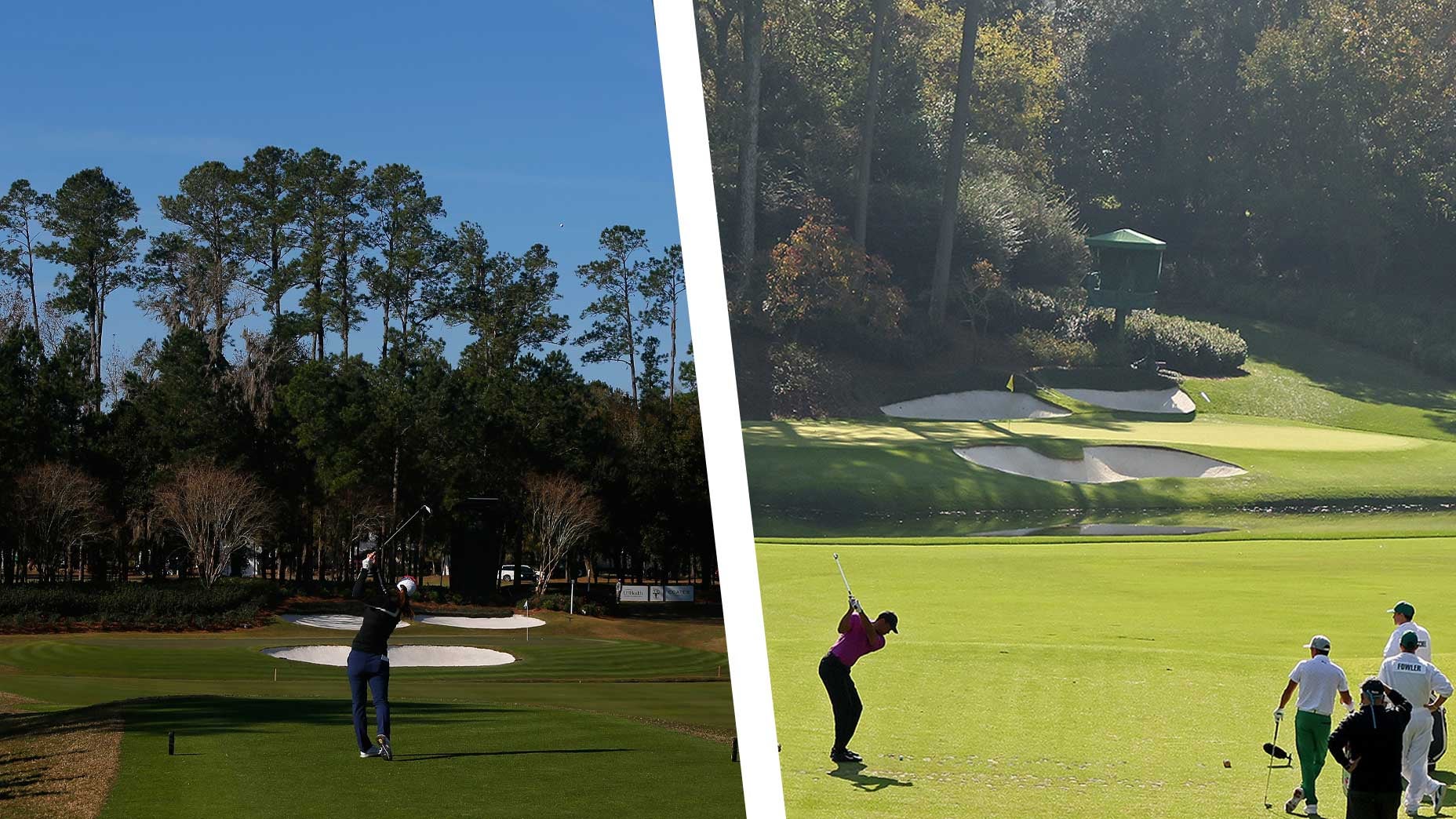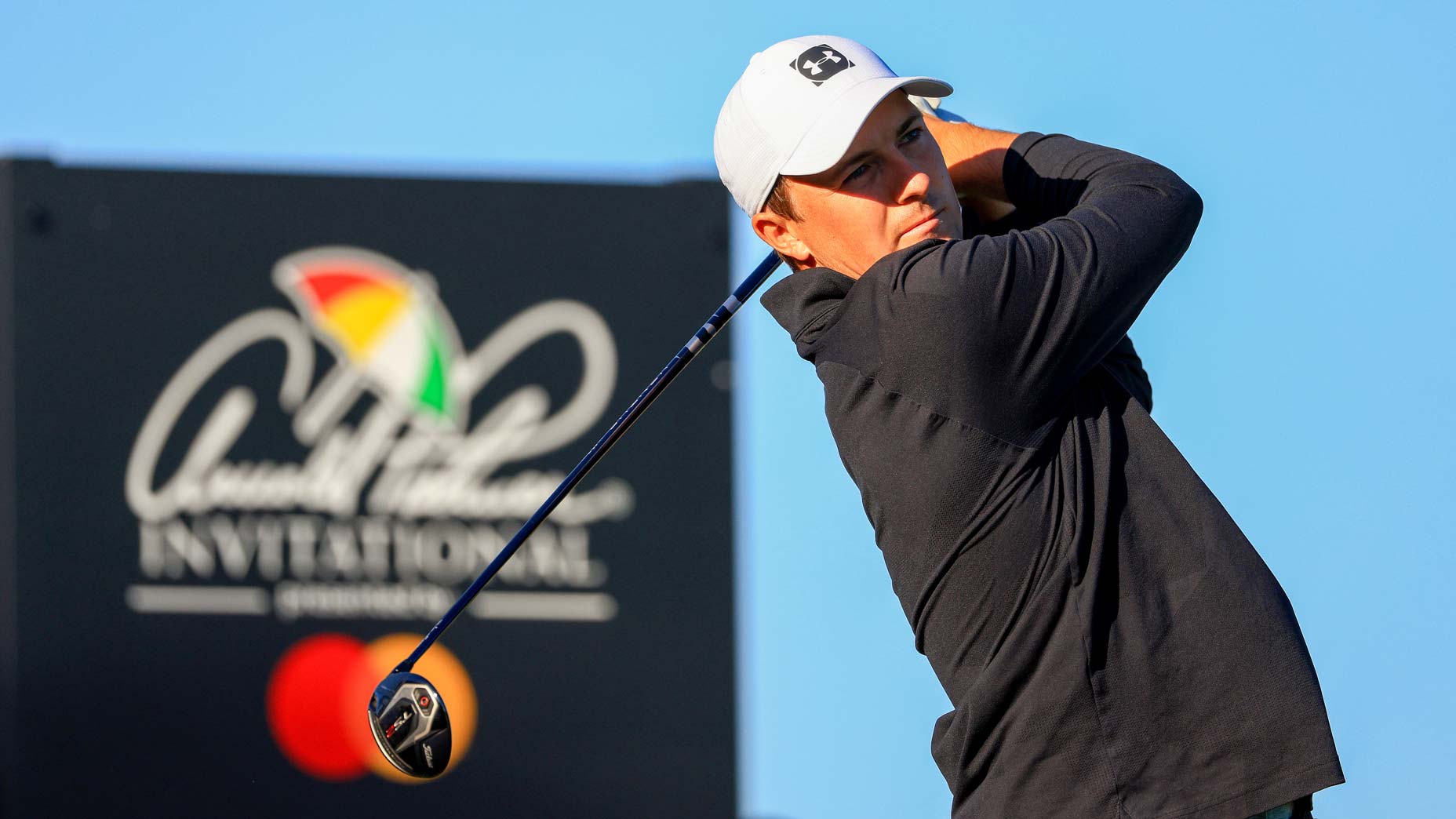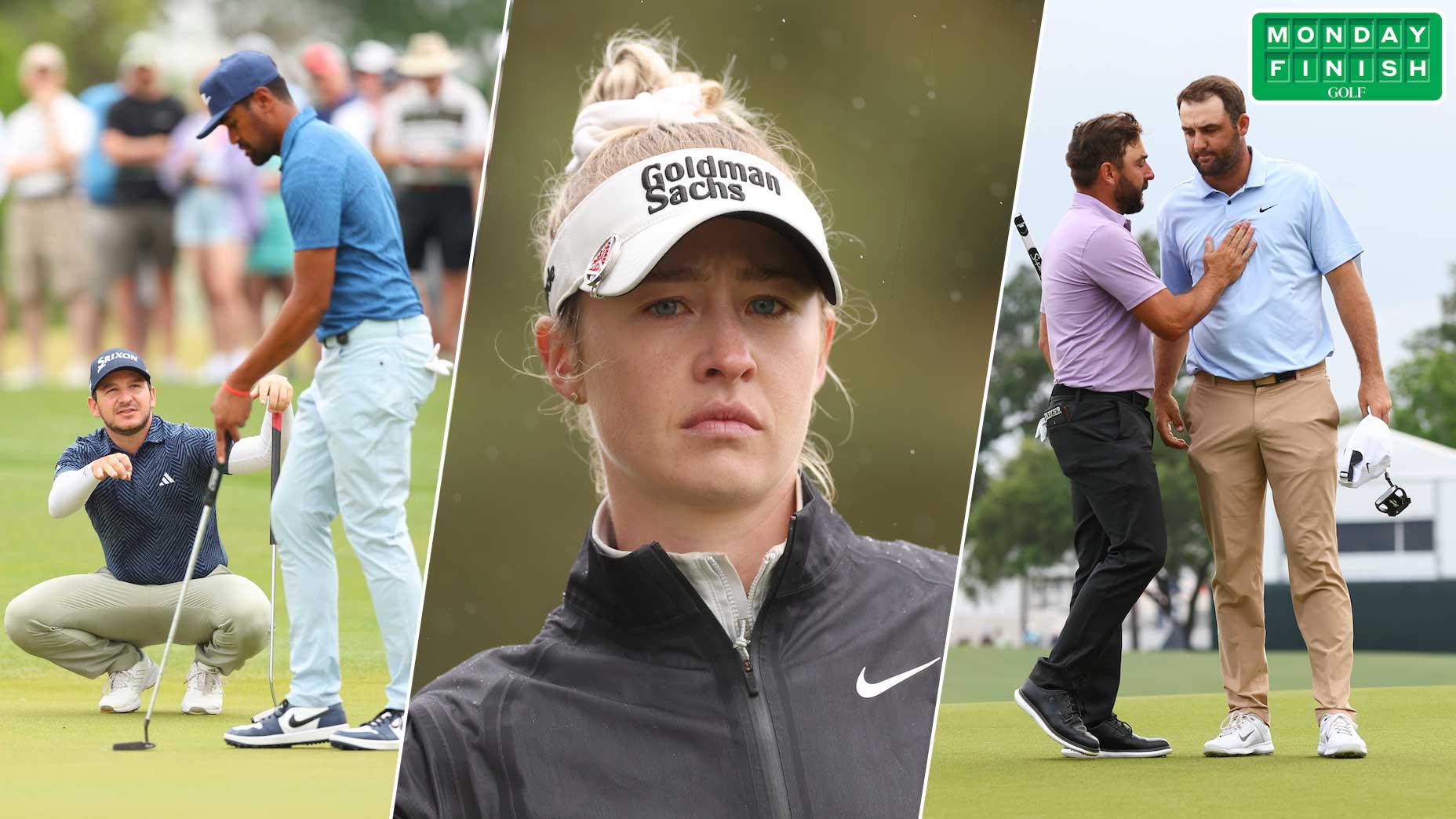Monday Finish: Bryson texting Tiger, faking Augusta National and Rory’s 7

Bryson DeChambeau headlined another wild week in the golf world.
Getty Images
Welcome to the Monday Finish! This is where we’ll tally the scores for the week that was and tee you up for the week to come.
FIRST OFF THE TEE
Something you might have missed.
Of all the pros you might have seen playing golf this weekend, you’d be hard-pressed to find any with a deeper love for the game than 57-year-old Dame Laura Davies. I say “this weekend” because Davies fired a bogey-free three-under 69 on Friday to make the cut at the Drive On Championship at Golden Ocala — and relished the chance to play on.
Davies is funny. She got fitted into a new set of irons this week, “Probably because I’m so old now they thought, ‘Oh, give her a bit of help,'” she said.
She’s self-aware. “I think the nerves have changed. I stand over shots now that I would have just hit carefree,” she said. “The nerve ends aren’t quite as good as they used to be when I was younger.”

And she’s continually ready to find inspiration, even after all these years. “You see [Bernhard] Langer go to the Masters and do really well. That sort of thing, in any mind I think, ‘Well, you know, I’m still a decent ball-striker,'” she said. “So that’s why I’m still here playing, because I can hit the shots. It’s just hitting them in the right order.”
Even if the order of shots now eludes Davies more often than she’d like, she seems better than ever at stringing words together in exactly the right sequence. The LPGA is dominated by young stars like 22-year-old Nelly Korda, who won last week’s event and seems primed for superstardom. So there’s something particularly cool about the fact that Davies is still fighting the good fight — and seeing results, too.
When Davies was growing up, she had several women she looked to for inspiration. Nancy Lopez. Chris Evert. Martina Navratilova. The Queen of England. (“She’s a pretty special lady,” Davies said.) And now, with the power of hindsight, she has a piece of advice for younger players.
“I think it’s tough old game out there, playing this particular sport professionally,” she said. “They need to give themselves a little bit of a break. They are very hard on themselves. That’s what I see from a distance.”
Davies ran out of steam by the end of the weekend, closing with a 44 on her final nine to finish 70th. She’s earned nearly $10 million in her career on the course; in Ocala she cashed a check for $3,030. But Davies has made one thing clear: She’s not in it for the money.
If you need someone to pull for this year, you could do worse than Davies. She’s back in action in April — and she’s got plans for a big summer.
WINNER’S CIRCLE
Who won what?
Bryson DeChambeau won his eighth career PGA Tour event at the Arnold Palmer Invitational, holding off Lee Westwood for his first victory since the U.S. Open in September. Bay Hill may not have visible similarities to Winged Foot, but their shared attributes — firm, tight fairways, slippery greens, tricky wind and high rough — seemed to play into DeChambeau’s hands. When chaos reigns, the man with all the little advantages has the biggest advantage. He’s your world No. 6.
Austin Ernst threw down a decisive five-shot victory at the Drive On Championship at Golden Ocala. Ernst led Jennifer Kupcho by one entering Sunday’s final round, but birdied 4-5-6-7 to extend that lead to six. Kupcho closed the gap midway through the back nine, but Ernst held steady as Kupcho ran into a double bogey at 15 that sealed Ernst’s win. Because Jessica and Nelly Korda claimed the first two events of the season, Ernst’s victory means American women are now three-for-three in 2021.
ALMOST-WINNER’S CIRCLE
Who came up just short?
Lee Westwood seized the API lead heading to Sunday, setting up a classic David-vs.-Goliath showdown. That’s not to say that Westwood is any sort of slouch — he’s a strong guy, hits it plenty far and has proven he can still win on the highest level. Still, he’s a 47-year-old who hasn’t won on U.S. soil in a decade trying to take down golf’s game-breaking revolutionary on a day when the field’s scoring average soared under tough conditions. Westwood held his own; he was a DeChambeau four-footer from a playoff. But regardless of the outcome, he seemed to enjoy the fight. And showed a proper sense of humor, too:
“I thought we had a really good battle,” he said after coming up one shot short. “It was a day for playing sensible and hanging on and grinding out pars.”
Did Corey Conners have a good finish or a bad one? He finished bogey-eagle-bogey-bogey for solo third, three shots outside of the playoff. That was a sign of the golf course as much as anything, though: Nos. 15 and 17 played nearly a half-shot over par on Sunday, while players averaged slightly worse than bogey on No. 18. No. 16, on the other hand, was a par-5 in name only, yielding more birdies than pars and averaging 4.278 on Sunday. Par is just a number, and Conners logged the second-best result of his PGA Tour career.
How did Jordan Spieth feel about a Sunday 75 that left him T4? “I thought I played really well. I thought I played a really solid round of golf,” he said. He’s now been in Sunday contention in each of his last four starts, and even though he hasn’t gotten the job done he seems more than optimistic — and added that this was . “I put the ball exactly where I wanted to on just about every single shot and putt and it came out to 75 somehow.”
On the LPGA, Kupcho’s second-place finish was nothing but encouraging. That’s not to say we shouldn’t expect her to win soon — that’s how you get to be a truly great player — but as we approach the second anniversary of her win at Augusta National, she’s clearly shown an ability to compete in the game’s brightest lights. In fact, the only surprising thing about Kupcho’s week was when she said after Sunday’s round that she didn’t think it was realistic that she’d be able to qualify for the U.S. Olympics team. In fact, she’s currently the 12th-ranked player in the world and the fourth-ranked American, which means she’s already in position to make it to Tokyo. The U.S. team would be lucky to have her.
COURSE TALK
What didn’t you see about No. 6 at Bay Hill?
If you’ve been anywhere near the internet in the last week you’ve likely seen and read plenty about what Bryson DeChambeau did at No. 6, so I’ll be brief. First, if you’re looking for a visual to show just how far ahead of the field DeChambeau’s tee shots on Saturday and Sunday ended up, here they are:
Also, if you’re looking to see what the scene was really like on No. 6 tee on Saturday, give this video a watch:
We learned plenty from watching DeChambeau tackle this tee shot. We were reminded that he loves being an entertainer, we saw a very tangible manifestation of his speed training and we saw that with his carry distance, he could easily cut off even more. But I’d argue we learned even more from watching Rory McIlroy play No. 6 this week.
Through two rounds, it was actually McIlroy, not DeChambeau, who had bitten off the largest chunk of carry, hitting it slightly past him on both Thursday and Friday (see below).
And on Saturday, when DeChambeau hit it 370 over the corner, McIlroy wasn’t actually so far behind (and still way ahead of the rest of the field):

Through three rounds McIlroy was three under on No. 6, one shot better than DeChambeau. But Sunday was when the fireworks began. McIlroy sent his tee shot on a similar line to the first three days, but due to either miscalculation or mishit he came up ever so slightly short of carrying the water. Splash. Then he did it again. Splash. Now hitting 5, he striped driver slightly farther right and followed that by hitting a glorious long iron to three feet for what turned out to be arguably the best double bogey I’ve ever seen.
Unfortunately, a great 7 still knocked him out of contention, but it perfectly illustrated the feast-or-famine approach that comes with tackling No. 6. If you don’t pull off the massive carry, the penalties are severe. Finally, the carry to the corner where McIlroy hit it Sunday is nearly as long, if not longer, than the line DeChambeau took. It’s a bit like hitting a deep fly ball to center field. Given Sunday’s wind direction — down and right-to-left — McIlroy’s line may have actually been riskier than DeChambeau’s.
Can’t wait for next year!
One last course note: We’d be remiss to ignore the Augusta National replica holes in play on the LPGA this week, which Sean Zak wrote about here. Nobody would mistake them for the real things, but at the same time it’s fun to see a different take on some of the game’s most familiar holes.

More to the point, I’m reminded that I’d like to see the LPGA take on the real thing. The ANWA is terrific and provides a huge, unique spotlight on the women’s game — but seeing the best women in the world competing at Augusta would give us an entirely new appreciation for the game.
WHAT WE’RE HEARING
Sunday blues.
That double-bogey 7 was an integral factor in Rory McIlroy’s final-round 76, which dropped him from contention to T10. Afterwards, he was feeling rather glum:
“I feel okay,” he said. “There was some good parts this week again. Some stuff that I’m sort of, I don’t know what the word is or how to describe it, but just a little dejected or — I don’t know, like, maybe looking to go in a different direction. I don’t know. I need something, I need a spark, I need something and I just don’t seem to have it. Some days it’s good, some days it’s not.”
We love listening to McIlroy because he thinks out loud. He means what he says — at least, he means it while he’s saying it — so when he says he’s a little dejected, we can trust that to be true. But it’s tougher to interpret whether the “different direction” and “spark” he’s referring to means anything concrete or whether he’s just worn out after a disappointing finish to a long week of competition. Time will tell. We’ll be listening.
WHAT WE’RE WATCHING
What will Bryson do next?
After his victory, DeChambeau was asked whether we’ll see an equivalent to his bold approach to No. 6 at Bay Hill this week at TPC Sawgrass. His eyes lit up as he explained that he’s considered playing from the 18th tee over onto No. 9, setting up an approach back over the water to the 18th green. Here’s what that would look like, roughly:

So why do it? Here was DeChambeau’s explanation:
“It just gives you a better shot into the green, I think, personally, where you can just hit it a little long and you’re always going to be okay. Considering if you try and hit the fairway out to the right…” Mid-muse, DeChambeau caught himself. “It’s probably not worth it. I mean, the cover’s like 310, but we’ll see. I just, I look at all options and hopefully there’s an advantage there. But if not I’ll just hit 4-iron down the fairway and hopefully an 8-iron or 7-iron into the green.
To build out the rest of that case: No. 18 at TPC Sawgrass is one of the most difficult tee shots on Tour, and the second shot is no picnic either. For someone like DeChambeau, it’s easier to guarantee carry distance than exact line off the tee, so it’s probably easier hit it over the water (to the left) than thread driver down the intended fairway. Same thing on the approach: It’s often easier to play over a body of water that’s just short of the green than it is to negotiate water left of the green. That’s why so many players bail out right on their 18th-hole approach shots.
He probably won’t do it. But in classic Bryson fashion, the fact that he has us all thinking about it is value enough.
CLOTHING CORNER
To the victor go the spoils, and on Sunday that meant DeChambeau walked away with an Arnold Palmer-style cardigan, the prize of every Bay Hill champ. What size did he slip into?
“XL,” DeChambeau said. “And it barely fits!”

Speaking of cardigans — and what better space to do it than this? — two men are famous for wearing red cardigans: Arnold Palmer and Mr. Rogers. But did you know that those two grew up in Latrobe, Pa., together? Or that a young Fred Rogers learned golf from Arnold’s father Deacon Palmer at Latrobe Country Club? What a neighborhood.
DeChambeau was visibly moved by slipping on a piece of clothing with so much history. He spoke with reverence about Palmer, and also made the connection between the cardigan’s color and the trademark Sunday Red of Tiger Woods.
“I think this red cardigan is not only for Mr. Palmer, but I would say it’s a little bit for Tiger as well, knowing what place he’s in right now,” he said.
Woods texted DeChambeau on Sunday morning, providing some inspiration as he sought his first victory at a place where Tiger has won eight times. It’s a good sign that Woods is doing well enough that he’s attuned to the golf world — and whatever he told DeChambeau clearly worked.
TOO GOOD TO BE TRUE
His name was what?
A couple weeks ago, a man snuck into Augusta National and led police on a chase because, as he told deputies later, he “was bored” on a Saturday night.
The bit that’s particularly rich is that the 26-year-old trespasser’s name is “Grayson Beveridge.” That’s “Beveridge” as in the item he may have consumed a few too many of before taking on the world’s most secure golf course.
WHAT’S NEXT
Three things to watch this week.
1. Jordan Spieth. Can he continue to contend on an even bigger stage, against an even bigger field? Spieth has proved plenty these last four starts, so we can now just enjoy the fact that one of the game’s most intriguing players is back in the mix.
2. Rory McIlroy. Is defending his Players Championship title — albeit two years later — all the “spark” he needs?
3. Tony Finau. He’s contended five events in a row, although as you may have heard Finau hasn’t walked away with a win just yet. The Players would be a heck of a place to do so.















